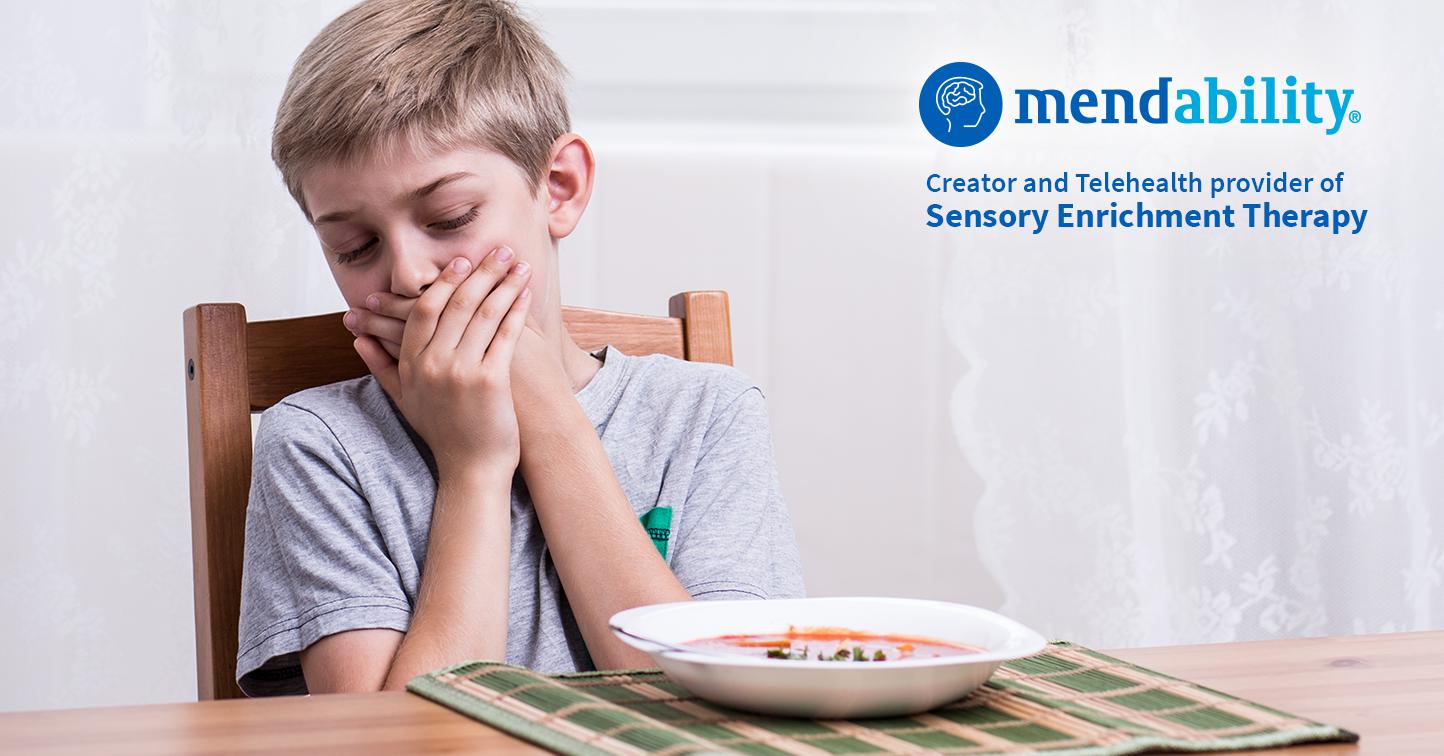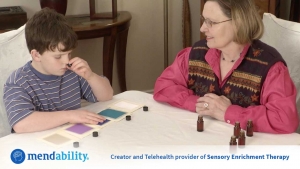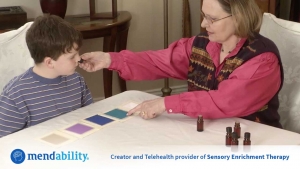What will your picky eater have at the next big family dinner?
What if we could show you how to help your autistic fussy eater try one new food comfortably?
For many families, sitting around the table for a long, relaxed meal to enjoy a family dinner with all of the traditional trimmings is only a dream. Indeed, such gatherings include many challenges for autistic individuals:
- Sensory and emotional overload, especially with large groups,
- Anxiety around changes in schedule and travel,
- Having to eat special foods,
- Higher expectations for table manners, and so on.
Sensory Enrichment Therapy can help autistic individuals feel more comfortable and more confident to engage in these high-stress situations and in everyday meals around the dinner table.
Today, we would like to focus on the sensory issues related to eating. Below you will find comments and exercises for picky eaters who have challenges with textures, then color, then smell.
We will share with you some exercises taken from our Sensory Enrichment Therapy program. While the full power of the therapy comes from customizing the exercises, we feel the suggested protocols will be helpful to you too.
Sensory processing issues that lead to picky eating
Food selectivity has not been operationally defined in a consistent manner and has been used to refer to picky eating, frequent food refusals, limited repertoires of foods, excessive intake of a few foods, and selective eating disorders.
A key factor that contributes to food selectivity is referred to as “food sensitivity”.
Food presents several types of sensory information that can be an obstacle for an individual on the autism spectrum:
- texture1,
- smell,
- color,
- and temperature.
There are also other issues that can impact the ability of a person with autism to eat a balanced diet, such as excessive attention to the branding and packaging of the food, or compulsions over the manner in which the food must be served.
It appears that texture is the most important sensory input that causes autistic individuals to react very adversely to specific foods.2 At the same time, we have seen that individuals with autism create their own preferences around foods which they feel are safe.
Exercises that can help picky eaters with autism who struggle with sensory processing issues
Research has confirmed that sensory processing problems are at the root of food selectivity. Sensory Enrichment Therapy will help you gradually decrease the nervousness that your autistic child feels when he or she is presented with new foods and new textures. This therapy for children and adults with autism can also help to increase their desire to try new foods. Parents and caregivers implementing Mendability therapy have commented that their children gradually expanded the range of foods that they would eat until their eating habits and preferences were similar to those of typically developing children.
Click on this video to watch a video of Mickey, who ate solid food for the first time in 14 years, after a few weeks of Sensory Enrichment Therapy.
Fussy eaters because of texture
Sensory Enrichment Therapy Exercise: Art Match with Textures
This is a great tactile processing exercise which the child controls. Gather an image of a work of art and a few different textures, such as a piece of velvet, a piece of aluminum foil wrapped around a piece or cardboard, a piece of sandpaper and a piece of corrugated cardboard.
Point to one item on the picture, e.g a footpath in a landscape, and ask your child to feel each texture to decide which is the closest, in his mind, to the feel of the path.
If you do this exercise at least once a day, you will have expanded the catalog of accepted textures in his brain, with no connection to food. With a more accepting brain concerning textures, your child can become more open to foods with different textures.
The following exercises come from the full therapy program and may be helpful to you as well. For more information about doing Sensory Enrichment Therapy at home, visit our therapy page.
Sensory Enrichment Therapy Exercise: Multi-texture Path
Create a path in your home with various textures such as a plastic doormat, a bathroom mat, a wool sweater, a ceramic tile and anything else that provides some contrast. Place the various components so that, as you walk along the path, each step lands on a different texture. This exercise can help with food sensitivity because expanding a person’s tolerance for different textures is actually not a mouth problem at all. Resistance to the texture of food is related to how the brain processes the sensory information from food and this can be solved with experiences at any level of the body.
Fussy eaters because of smell
After tactile defensiveness, smell is generally the next reason for a fussy eater to resist food.
How can you tell if smell is the reason why someone is fussy with her food? Does she comment about smells frequently, when entering a store, or stepping outside, or in public bathrooms, etc.? Does she try to cover her nose? Does she smell her hand?
It is possible to reduce olfactory aversions by implementing Sensory Enrichment Therapy.
Sensory Enrichment Therapy Exercise: Sensory Association – Scents and Textures
This is a matching game to help your child experience a variety of smells and textures. Prepare three small pieces of fruit, a vegetable, a spoonful of jam or any other food with a distinctive aroma so that the individual can smell the items but not see them. For example, you could wrap a piece of cucumber in a Kleenex and place it in a mug, then do the same with a piece of orange and a piece of strawberry. You will also need three different textures, e.g. a sponge, a hair brush and a piece of corrugated cardboard.
Pair up the cups and the textures on a table in front of your loved one. He should try to memorize which texture is associated with each scent. Show him each smell and the texture that goes with it. Do not name the smells. Then mix up the pairings and see if the individual can put them back in their original order. It does not matter if he is correct. While focusing on memorization, the individual will smell and touch several times, and expand his acceptance of new olfactory and tactile information.
Sensory Enrichment Therapy Exercise: Look and Smell
You can help your child build a more positive association with a new food if you introduce it at the same time as a food she likes. Here is an exercise that you can present as a game at the beginning of your mealtime. Prepare a food that your child likes and that you expect her to eat, as well as a food that she does not like. When the individual is sitting at the table at the beginning of your meal, ask her to close her eyes, bring the plate with the food she likes and ask her to smell the food and guess what it is. Then present the second dish with the non-preferred food. Again, make it a guessing game and ask the individual to close her eyes.
After guessing, place both dishes on the table so that your child can see and smell the non-preferred food while she is eating her chosen food. You are not trying to persuade your child to try to the new food. Instead, you are calmly showing her that you understand that she doesn’t like that particular food. You let your child eat her preferred food and tell her that she does not have to try the other food. If she is not resistant, then you may ask her to smell the non-preferred food again halfway through your meal.
Fussy eaters because of color
If your autistic child resists a particular food because of its color, then the Art Match with Textures exercise can also help in this situation (see above for instructions for this exercise).
This exercise involves looking at art and finding textures that match something in the picture. Looking at paintings with all their complexities of nuance and color requires the highest level of visual processing. When you do this exercise, the brain is analyzing and storing colors. Your child will be more able to welcome the colors on his plate after he has expanded his visual experience.
If you are able to do these exercises each day for a week, you should notice a decrease in your child with autism’s resistance to new foods.
Being together at the table can also help foster a more balanced diet
In addition to the Sensory Enrichment Therapy protocols, there is one thing that everyone can do in the days leading up to their holiday dinner.
Sometimes your concern for your loved one’s health can add stress to your mealtimes. Researchers gathered information showing that the tension of mealtimes can add to a child’s defensiveness3. They recommend emphasizing the pleasure of being together, remaining calm and making the mealtime as enjoyable as possible.
Hope for a balanced diet?
The protocols above have helped many autistic individuals overcome the sensory processing issues that prevented them from being able to enjoy a wide variety of foods.
References
- Ayres AJ. TACTILE FUNCTIONS. THEIR RELATION TO HYPERACTIVE AND PERCEPTUAL MOTOR BEHAVIOR. The American journal of occupational therapy: official publication of the American Occupational Therapy Association. 1964;18:6–11.
- Ornitz EM, Ritvo ER. The syndrome of autism: a critical review. The American journal of psychiatry. 1976;133(6):609–621.
- 3. Fiese BH, Schwartz M. Reclaiming the Family Table: Mealtimes and Child Health and Wellbeing. Social Policy Report. Volume 22, Number 4. Society for Research in Child Development. 2008 [accessed 2015 Nov 16]. http://files.eric.ed.gov/fulltext/ED521697.pdf
Is fussy eating an area of concern for you or your loved one?
Sensory Enrichment Therapy™ helps develop food differentiation by boosting brain development in these areas.
Join 3,000 families in over 60 countries who have used Sensory Enrichment Therapy™ to help boost brain development in their own homes.




Firstly: AUTISTIC PEOPLE/INDIVIDUALS, not people WITH autism. Secondly, sensory struggles surrounding foods not only include texture, smell, temperature and color but also taste. For me it is a big one, along with texture. My body physically cannot ingest certain foods and it is an automatic reflex. I tried to be my own therapist and use methods to help me cope but they don’t work. My family also had a very toxic relationship with food and so would criticize if I didn’t eat the ‘proper way’, ate too little, too much, or, alternatively, spat things out due to my still undiagnosed Autism. So no, certain foods make me ill and will continue making me ill no matter what I do. I’m not entirely picky but definitely more than your average allistic.
Thank you for chiming in, Meghan. It’s good to hear from our autistic community. We have definitely not included enough the people whom we’re trying to help. Sounds self-evident now that we are aware of it. In behalf of Mendability, please accept our best efforts, especially now that we are working with a couple of research teams to have our clinical data re-evaluated by autistic researchers.